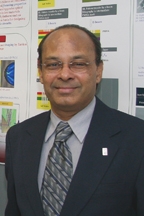Aug 27 2008
Using semiconductor nanotechnology, Srinivas Sridhar, Ph.D., Distinguished Professor and Chair of Physics at Northeastern University, and his team of researchers from the university’s Electronic Materials Research Institute have created a new microlens that focuses infrared light at telecommunication frequencies.
 Dr Srinivas Sridhar
Dr Srinivas Sridhar
The focusing power of this microlens sets a world record for one of the shortest focal lengths ever achieved, focusing the infrared beam to a spot just 12 micrometers away from the surface. This represents an advance in light imaging technology and has the potential to lead to innovations in how current personal electronic devices are manufactured.
The two-dimensional meta-material microlens, which uses the negative refractive index, was created by nano-engineering a photonic-crystal substrate into a multi-layered semiconducting wafer. The microlens focused infrared light to a location just 12 micrometers away from the lens surface – one of the shortest focal lengths recorded – at the limit of diffraction laws. In addition, the location of the focused light image was very sharp with little blurring.
“In order to go to the next level and create more efficient electronics, such as digital cameras, we need to explore ways to make things smaller,” said Sridhar. “This research shows that it is possible to create smaller, ultra-compact infrared optical components that can be integrated into existing semiconductor technologies while not sacrificing image quality.”
In addition to Sridhar, the team of researches involved with this project includes Bernard Didier F. Casse, Ph.D., Wentao Lu, Ph.D., and Yongjiang Huang, all from Northeastern’s Physics department. The report was published in the August 7 edition of the journal Applied Physics Letters. This work was also supported by the Air Force Research Laboratories and the National Science Foundation.
“Light imaging technology is a crucial component to the field of optoelectronics, which uses light instead of electrons for carrying information, and represents the next generation of combined optical and electronic platforms essential for future computers,” added Sridhar.